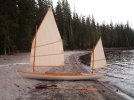I'm a longtime canoe tripper, but new to canoe sailing. This past summer, I put together a workable sailing rig for my old 20-foot Grumman and fooled around with a smallish four-sided sprit sail. Since that requires the mast to rotate in tacking, I installed a round mast step. I'm now in the process of upgrading to a larger balanced lugsail--a real one this time, in place of the homemade tape-and-Tyvek original. Since the lug sail mast is not supposed to rotate, I'm wondering if I can retain the round mast step. Will the tension of the downhaul be enough to prevent rotation of the mast? Or should I replace the round mast step with a square one?
Honesty compels me to state that the canoe is question is not a beautiful wood and canvas boat, but an old 20-foot Grumman. I hope that will not subject me to scorn, but if it does I suppose I can bear it.
Honesty compels me to state that the canoe is question is not a beautiful wood and canvas boat, but an old 20-foot Grumman. I hope that will not subject me to scorn, but if it does I suppose I can bear it.

